Serviços Personalizados
Journal
Artigo
Indicadores
-
 Citado por SciELO
Citado por SciELO -
 Acessos
Acessos
Links relacionados
-
 Similares em
SciELO
Similares em
SciELO
Compartilhar
Revista mexicana de ciencias agrícolas
versão impressa ISSN 2007-0934
Rev. Mex. Cienc. Agríc vol.9 no.8 Texcoco Nov./Dez. 2018 Epub 06-Out-2020
https://doi.org/10.29312/remexca.v9i8.1725
Description of cultivar
VCS-Tornasol: cultivar of white forage sorghum for the state of Sinaloa
1Valley of Culiacán Experimental Field-INIFAP. Highway Culiacán-El Dorado km 17.5, Culiacán. Sinaloa. ZC. 80000. (guzman.jesus@inifap.gob.mx; moreno.jesus@inifap.gob.mx; loaiza.alfredo@inifap.gob.mx).
2Valley of Santo Domingo Experimental Site -INIFAP. Transpeninsular Highway km 208, Cd. Constitución, BCS, Mexico. (cmelgozavillagomez@gmail.com).
3Autonomous University of Sinaloa-Faculty of Veterinary Medicine and Zootechnics. San Ángel 3886, Mercado de Abastos, Fracc. San Benito, Culiacán, Sinaloa, Mexico. ZC. 80260. (Luis-albertohernandez@yahoo.com).
4Río Bravo Experimental Field-INIFAP. Road Matamoros-Reynosa km 61, Rio Bravo, Tamaulipas, México. AP. 172. ZC. 88900 (montes.noe@inifap.gob.mx).
Mexico is the fourth world producer of sorghum (Sorghum bicolor L. Moench.) with a 10% of world production, 94.3% goes to the production of balanced feed for livestock. In Sinaloa, 70% of the sorghum is grown under rainy season conditions corresponding to the spring summer cycle, with average yields of 1.29 t ha-1 of grain and 9.54 t ha-1 of green fodder. In recent years it has been possible to identify new genotypes with greater tolerance to diseases than commercial hybrids, so in the program of genetic improvement of sorghum of the Valley of Culiacan Experimental Field the variety ‘VCS-Tornasol’ was released, which presents greater tolerance a: ergot caused by Claviceps african, anthracnose caused by Colletotrichum graminícola, blight of the panicle caused by Fusarium moniliforme and carbonaceous rot of the stem caused by Macrophomina phaseolina. It is currently registered in the National Catalog of Plant Varieties (CNVV) of the SINCS with the number SOG-285-231117 and number of breeder’s title 1889. The variety VCS-Tornasol is of intermediate vegetative cycle, has a plant height of 2.40 m, its spikes are medium (24 cm), semicompact, with good excersion (30 cm), the grain is cream or amber, circular and semi-flat, with testa and endosperm crystalline and medium texture. In yield trials carried out over a period of six years during the spring-summer cycle under temporary, VCS-Tornasol yielded an average of 3 100 kg ha-1 of grain, exceeding by 9.67% the average of three commercial controls, the production of low forage temporary conditions yielded on average 39 775 kg ha-1, surpassing 49.21% to the average of the commercial control.
Keywords: Sorghum bicolor L.; forage; grain; resistance to diseases
México es el cuarto productor mundial de sorgo (Sorghum bicolor L. Moench.) con 10% de la producción mundial, 94.3% es para la elaboración de alimentos balanceados para la producción pecuaria. En Sinaloa, 70% del sorgo, se cultiva bajo condiciones de temporal que corresponde al ciclo primavera verano, con rendimientos promedio de 1.29 t ha-1 de grano y 9.54 t ha-1 de forraje verde. En los últimos años se identificó nuevos genotipos con mayor tolerancia a enfermedades que los híbridos comerciales, por ello el programa de mejoramiento genético de sorgo del Campo Experimental Valle de Culiacán liberó la variedad ‘VCS-Tornasol’ que posee mayor tolerancia a: ergot causada por Claviceps african, antracnosis causada por Colletotrichum graminícola, tizón de la panoja causada por Fusarium moniliforme y pudrición carbonosa del tallo causada por Macrophomina phaseolina. Se encuentra inscrita en el Catálogo Nacional de Variedades Vegetales (CNVV) del SINCS con el número SOG-285-231117 y número de título de obtentor 1889. La variedad VCS-Tornasol es de ciclo vegetativo intermedio, tiene una altura de planta de 2.4 m, sus espigas son medianas (24 cm), semicompactas, con buena excersión (30 cm), el grano de color crema o ámbar, de forma circular y semiaplanada, con testa y endospermo cristalinos y de textura media. En ensayos de rendimiento realizados en un período de seis años durante el ciclo primavera-verano bajo temporal, VCS-Tornasol rindió en promedio 3 100 kg ha-1 de grano superando en 9.67% al promedio de tres testigos comerciales, la producción de forraje bajo condiciones de temporal rindió en promedio 39 775 kg ha-1, sobrepasa 49.21% al promedio del testigo comercial.
Palabras clave: Sorghum bicolor L.; forraje; grano; resistencia a enfermedades
Mexico is the fourth world producer of sorghum (Sorghum bicolor L. Moench.) with a 10% share of world production; however, it is the main importer of this grain with an average volume of 2.35 million tons (SIAP, 2018). In Mexico, 94.3% of sorghum is used for the production of balanced feed for livestock production and in recent years, there has been an increase in consumption in the country (Gámez-González et al., 2010).
In Sinaloa, 70% of sorghum is grown under rainy season conditions corresponding to the spring summer cycle, with average yields of 1.29 t ha-1 grain and 9.54 t ha-1 green fodder, respectively (SIAP, 2018). Among the main problems facing the cultivation of sorghum in Sinaloa are drought, as well as the scarce use of conservation practices and use of moisture.
In recent years, it has been possible to identify new genotypes with greater disease tolerance than commercial hybrids, among them the new variety VCS-Tornasol that has greater tolerance to: ergot caused by Claviceps african, anthracnose caused by Colletotrichum graminícola, blight of the panicle caused by Fusarium moniliforme and carbonaceous rot of the stem caused by Macrophomina phaseolina (Williams-Alanis et al., 2009).
The Genetic Improvement Program of Sorghum of the Valley of Culiacan Experimental Field (CEVACU) of the National Institute of Forestry, Agriculture and Livestock Research (INIFAP), released the new variety ‘VCS-Tornasol’ in 2017, which was obtained through genetic recombination and selection. The germplasm that gave rise to this variety was introduced during 1986 to CEVACU, in Sinaloa, Mexico, from the International Institute for the Improvement of Crops of the Semi-Arid Tropics International Crops Research Institute for the Semiarid Tropics (ICRISAT), Hyderabad, India. His progenitor lines were an androsterile female and a male restorer of fertility, of unknown genealogy; to the cross was assigned the denomination V-2 (Variety-2).
The selection of the segregating material of the V-2 cross was initiated from generation F2, by the groove method per panicle or pedigree for seven generations. In this way, the advanced uniform line was obtained that gave rise to ‘VCS-Tornasol’, and whose pedigree is: V2-1-M-3-1-1-2-M-M.
From 2002 to 2012, this variety was evaluated in yield trials under rainfed and irrigated conditions, in several locations in the state of Sinaloa, Mexico. It is currently registered in the National Catalog of Plant Varieties (CNVV) of the SINCS with the number SOG-285-231117 and breeder’s title number 1889.
The description of the variety of sorghum, was made using the descriptors of the Union of Variety Producers and Breeders (UPOV), in the south and center of Sinaloa, where the predominant climate is dry tropic, with precipitation between 450 and 600 mm, during the spring-summer cycle in rainy or dry season conditions, the VCS-Tornasol variety has an intermediate vegetative cycle, with 65 to 70 days at flowering and 115 to 120 days at harvest, it has a plant height of 2.4 m, its leaves are light green, medium texture, without anthocyanins; its stem has eight internodes at maturity and the juice of this one has a concentration of soluble solids of 18 to 19 ºBrix, when the plants have the doughy milky grain. It has medium spikes (24 cm), semi-compact, with good excersion (30 cm) and glumes without anthocyanins in flowering; the grain is cream or amber, circular and semi-flat, with a crystalline testa and endosperm, and medium texture.
In yield trials conducted over a period of six years (1999 to 2005) during the spring-summer cycle under temporary, VCS-Tornasol yielded on average 3 100 kg ha-1 of grain exceeding 9.67% to the average of three commercial controls.
During the spring-summer 2006 to 2012 seasons, forage production was evaluated under rainfed conditions, VCS-Tornasol yielded an average of 39 775 kg ha-1, surpassing 49.21% of the commercial control average.
The bromatological quality of the irrigated forage, during the autumn-winter cycles of 2006 to 2012, was 77.99% of digestibility and 6.32% of protein, exceeding in digestibility and in protein content the commercial control with 21.79 and 0.52%, respectively, by which is considered to VCS-Tornasol as a dual-purpose material (Hernandez-Espinal et al., 2010).
On the other hand, in the physical and chemical analysis of sorghum grains it was found that the physical dimensions of this variety (length, width and thickness) are 4.14, 3.95 and 2.5 mm, respectively, while the weight of 1 000 grains of the variety VCS-Tornasol is 27 ±0.5g.
The chemical composition of the sorghum grains VCS-Tornasol showed a content percentage of proteins, lipids, ashes and carbohydrates of 10.02, 3.39, 1.62 and 84.97%, respectively. Therefore, with the agronomic characteristics of the forage and the physical and chemical characteristics of sorghum grains, VCS-Tornasol is proposed as a new potential variety to be cultivated in the state of Sinaloa (Figure 1 and 2).
Acknowledgments
Thanks to Fundacion Produce Sinaloa, AC for the financing of the project 'Generation of technology of varieties and hybrids of sorghum for seasonal and irrigation in Sinaloa'. Likewise, Octavio Macias and Lorenzo Vega are thanked for their hard collaboration in the breeding program for sorghum.
REFERENCES
Gámez, G. H.; Moreno, L. S.; Zavala, G. F.; Morales, R. I. y Damián, H. M. A. 2010. El sorgo: contribuciones al conocimiento de su fisiología. Primera edición. Ed. Talleres de Jiménez Editores e Impresores, SA de CV México, D. F. UANL. 2 p. [ Links ]
Hernández, E. L. A.; Moreno, G. T.; Loaiza, M. A. y Reyes, J. J. E. 2010. Gavatero-203, nueva variedad de sorgo forrajero para el estado de Sinaloa. Rev. Mex. Cienc. Agríc. 1(5):727-731. http://www.scielo.org.mx/scielo.php?script=sci-arttext&pid=S2007-09342010000 500013. [ Links ]
SIAP. 2018. Servicio de Información y Estadística Agroalimentaria y Pesquera. Anuario estadístico de la producción agrícola 2016 en México. El cultivo de sorgo. SAGARPA. [ Links ]
Williams, A. H.; Pecina, Q. V.; Montes, G. N.; Palacios, V. O.; Arcos, C. G. y Vidal, M. V. A. 2009. Reacción de variedades de sorgo para grano a Macrophomina phaseolina (Tassi) Goid. Rev. Mex. Fitopatol. 27(2):148-155. http://www.scielo.org.mx/scielo.php?script=sci-arttext&pid=S0185-33092009000200007. [ Links ]
Received: November 2018; Accepted: December 2018











 texto em
texto em 




